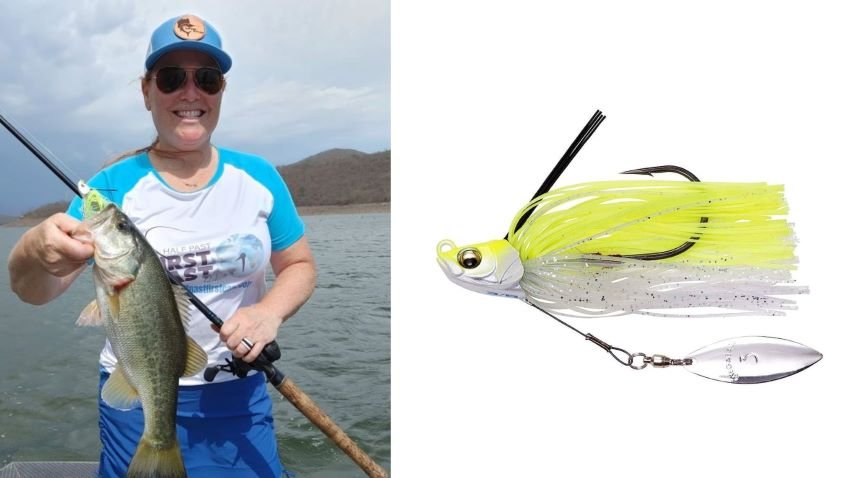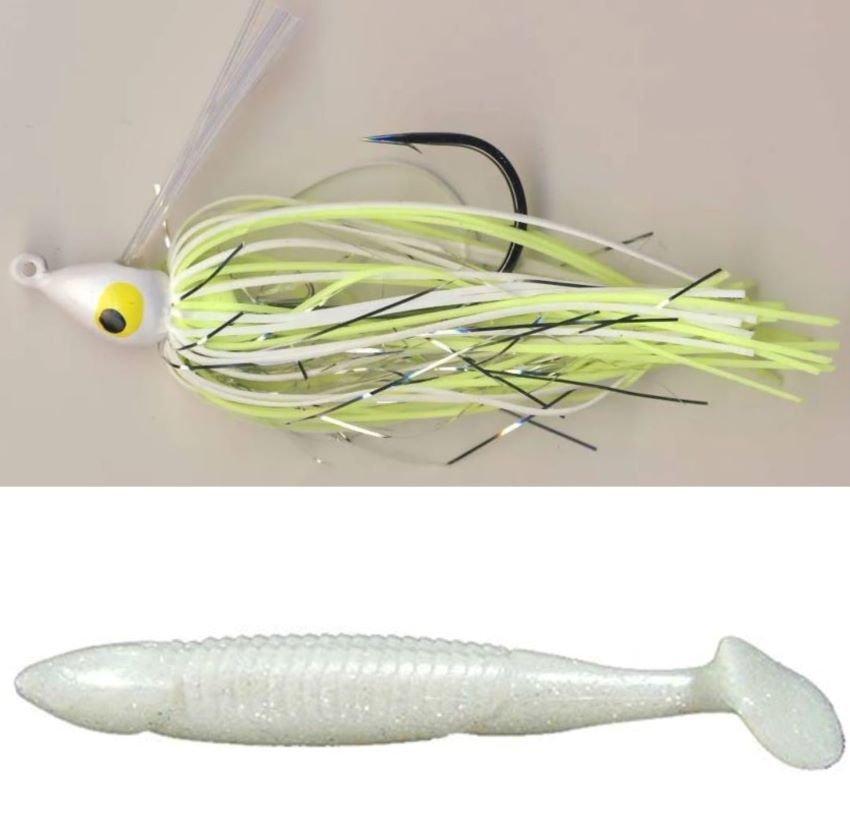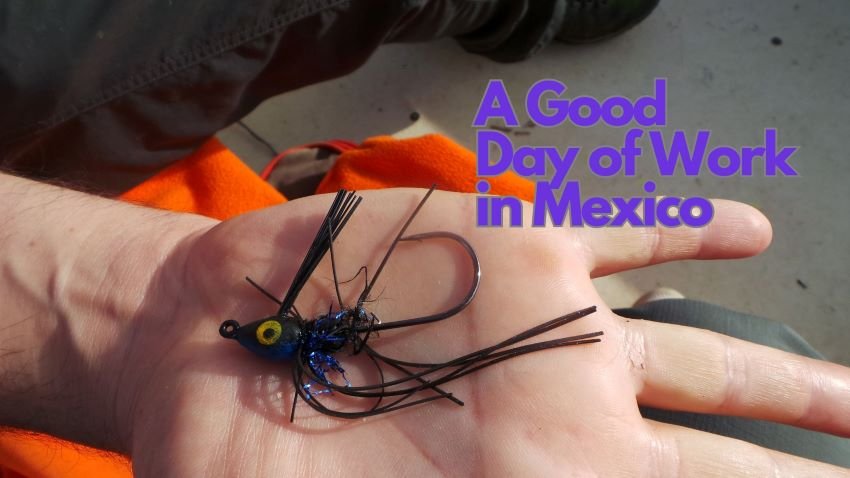Swim Jigs for Lake El Salto and Lake Picachos
We’ve had some tremendous days and trips fishing in Mexico with spinnerbaits and Chatterbaits, and we’ve written about them extensively, but one really valuable lure category that we haven’t discussed nearly as much is the swim jig. Sometimes we even forget about them, but they’re really valuable mop up tools. Moreover, a decent selection doesn’t take up much room in your luggage or your tackle bag, they don’t weigh much, and you’re not likely to lose a ton of them. Be sure to pack a handful on your next trip.
When Should You Fish Swim Jigs in Mexico?
Admittedly, I don’t always lean into throwing a swim jig right from the jump, but I can think of several times in our twenty or so trips to Anglers Inn when they’ve made a difference. Usually it comes down to three main factors:
Unusual pressure or an otherwise tougher-than-usual bite
Need to cover water
Heavy cover
It’s not necessarily a matter of water depth or time of year, although as you’ll read below we’ve applied them and chosen specific jigs based on seasonally-specific conditions. Usually they’re a failsafe, when we’ve seen a good bite gradually deteriorate or when we hope to catch a few extra fish from a good spot that has inexplicably cooled down.
I think of one January trip when the water was very high, and there was so much flooded cover that it was hard to get to or even near the bank. I find the swim jig to be more snagless than either a spinnerbait or vibrating jig, so I could throw it into the thickest mess and get bites that others weren’t targeting. As the week progressed, the fish that had been eating more aggressive baits earlier along the edges moved deeper into the cover and the swim jig was the best tool, with a Keitech rigged on an Owner Flashy Swimmer a second choice when a slower retrieve was necessary.
Alternatively, while we’ve used them shallow in the summertime we’re more likely to use them on offshore structure, often a ¾ ounce or even a one ounce model that we fish much like we would a Storm Wildeye Shad, slow-rolling it on the bottom. My favorite way to attack these schools is with a crankbait, but there are times that the bass won’t react positively to such a hard-charging lure. If you want to go more slowly, a football jig or Texas Rig is a great strategy for catching those stragglers, but when it’s necessary to cover a bit more water, a big swim jig will sometimes get more bites than the Storm or an unadorned hollow belly.
Which Swim Jigs Work Best Shallow?
I’m a huge fan of the Brovarney Baits swim jigs, a “Wisconsin-style” swim jig that I have more confidence in than any other. It has a weedguard that limits snags, but I have a sneaky suspicion that it has more purpose than that – it provides a perfect amount of self-centering body roll.
While the hook looks to be very thin wire, I can attest that it is extremely stout – I’ve used it to winch in bass over 7 pounds on 50-pound test braid from the heart of a stand of thick bushes. While I normally use a ¼ ounce at home on the super-shallow Potomac, in Mexico I prefer a 3/8 or ½. In fact, ½ may be the best all-around choice, allowing you to go from very shallow to offshore cover up to 15 feet deep with ease and with a single tool.
If for some reason you don’t want to fish the Brovarneys, some of the other shallow swim jigs that I like with braid (my shallow water choice in Mexico), include:
I certainly haven’t tried them all, and there are tons of choices, so find one you like and that you trust to handle bigger-than-average fish on heavy gear, and pack a small selection.
Which Swim Jigs Work Best Deep?
Once you’re getting out past about the 12 to 15 foot mark, you’ll likely going to need to go up to at least a ¾ ounce model, sometimes more – especially if there’s wind, or you want to wind at a steady pace, or you’re using a bulky trailer. That chunk of lead will keep you near or in contact with the bottom.
In recent years, our absolute favorite for this purpose has been the ¾ ounce Megabass Uoze Swim Jig. It has great skirt colors, including multiple baitfish patterns, realistic eyes, and a small willowleaf blade for extra flash. They’re not inexpensive, but they run true out of the package and you’re simply not likely to lose many. It can also be used as a spinnerbait or vibrating jig substitute up shallow, but most of our usage has been on the deep side, paired with a Keitech style trailer, a Skinny Dipper, or even a hollow belly.
There are of course other choices. Some of the ones we’ve used successfully include:
Blade Runner Weedless Swim Jig (only intermittently available in heavier sizes)
Warbaits has a swim jig that comes in sizes up to 2 ounces, with a 7/0 hook, which may be a bit of overkill, but you’ll have to be the judge of that.
For purposes of this article, I’m leaving out non-skirted jigheads which may accomplish very much the same purpose, albeit with a little less flair. They’re vehicles for delivering a soft plastic bait, but in and of themselves don’t offer much attraction (except sometimes a small trailing blade).
Remember when choosing a swim jig for any purpose to adjust the hook size/diameter to the tackle you’ll be using. Because I often fish the deeper swim jigs on 17-20 pound fluorocarbon instead of the braid I use shallower, I need not use a shark gaff as a hook.
Swim Jig Colors and Trailers
On many of the US lakes and rivers I fish, from Okeechobee to the Potomac to the Cal Delta, I’ve relied a fair amount on a variety of bluegill-themed swim jigs – typically various shades of watermelon and green pumpkin with purple, orange, chartreuse and/or glitter accents. I’ve tried them in Mexico, and expected them to work, but the results have been subpar. Generally, we’ve done best with shad colors, whites or white with some chartreuse (and on one trip I smoked them with a solid chartreuse Brovarney). That’s not to say that other colors won’t work. I once had a great day on Lake Picachos with a red-skirted Chatterbait with a gold blade, using a bitten-off 10-inch black Power Worm as a trailer. Find what you have confidence in and don’t be afraid to switch.
When it comes to trailers, I almost always use a Reaction Innovations Skinny Dipper on my shallow swim jigs at El Salto. I’m trying to imitate baitfish and they do a solid job, they come in a huge range of colors, plus they’re relatively inexpensive and fairly durable. I’ve used craws and creature baits, but haven’t found them to be any more effective Buy some Dippers in of their shades of white in bulk and you can dip the tail if you want a tinge of chartreuse. For the black and blue swim jigs my favorite colors are Junebug, Low Blow and Penetration.
When fishing the heavier swim jigs as bottom bouncers, a Keitech style ribbed swimbait is often the top choices, but I’ll also substitute a hollow belly like a Basstrix Paddle Tail or a Berkley Power Bait Hollow Belly for additional bulk and a different appeal. Just remember that the more bulk you have, the more longer it’ll take to get the jig to the bottom and the more weight it will take to keep it there.
Swim Jig Tackle for Mexico
As noted above, I almost always use braid when fishing a swim jig shallow in Mexico – as low as 30 pound test when possible for max swimming action and casting distance, and as high as 50 for super close quarters, heavy cover fishing. Pick your favorite, most castable brand, preferably in a muted green or another camouflaged color and have at it. While I have fished the deeper jigs on braid, and even mono, they typically perform best on 17- to 20-pound test fluorocarbon. Again, since you won’t want to change it out more than once during your stay, pick a premium brand with minimal memory from the start.
I usually throw all these jigs on the same rod that I’d throw a ¾ ounce spinnerbait, slightly heavier than an “all-around” spinnerbait rod, but lighter than a small swimbait rod. It needn’t be the most expensive rod in your arsenal, and it should have some flex to allow the fish to get the lure (especially important when using low stretch line), but it should also be sensitive enough to discern a subtle “mush” bite in 30 feet of water. I prefer something in the 6’11” to 7’2” range for close quarters target fishing, and a longer rod (up to 7’6”) for open water or deep water fishing where I’m making long casts and trying to pick up a lot of line on the hook set. I’ll pair it with a 150- or 200-sized reel in the 6.5:1 to 7.3:1 range.
Notes on Swim Jig Fishing South of the Border
Because swim jigs are typically not one of our “first out of the box” techniques when we launch each trip in Mexico, it’s still an evolving art form, but one that has saved our bacon a few times. Here are a few more notes to spur your own interest and ingenuity:
Because the Citrus Shad crankbaits, and in particular the Fat Free Shad, are so iconic at El Salto, I love the idea of a Citrus Shad swim jig like those from Dirty Jigs, paired with a matching soft plastic trailer.
While we tend to use the ¾ ounce and larger versions out deep, remember that Elite Series pro Steve Kennedy has won tens of thousands of dollars (and nearly won the Bassmaster Classic at Lake Conroe) swimming a ¾ ounce D&L Advantage Jig, usually with a Zoom Super Chunk.
If you thread your trailers onto the hook, ideally there will be some sort of bait keeper or barb to secure them in place. Alternatively, bring Super Glue or some sort of other adhesive.









